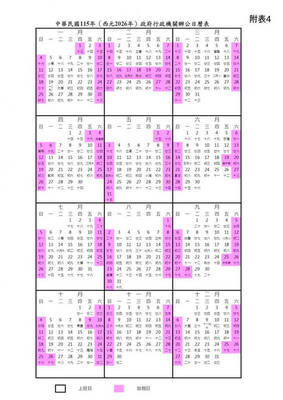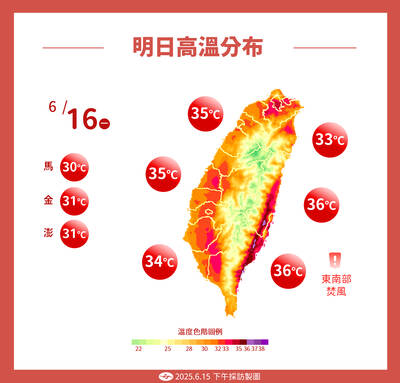The Executive Yuan should allow at least 1 million Chinese tourists to visit Taiwan per year to boost tourism revenue and maintain peace across the Taiwan Strait, experts said yesterday in a panel discussion hosted by the National Policy Foundation.
Taiwanese made 11.8 million trips abroad last year, with total travel expenditure exceeding NT$713.4 billion (US$21.93 billion), Tourism Administration data showed.
By contrast, international travelers made only 6.48 million visits to Taiwan last year, spending an estimated NT$269.8 billion, the data showed.

Photo: David Chang, EPA-EFE
The tourism revenue deficit between outbound and inbound travelers reached NT$443.6 billion last year, up by NT$71.7 billion from the pre-COVID-19 pandemic level in 2019.
About 11.8 million international tourists arrived in 2019, of which 2.71 million were Chinese, the data showed.
Although the government has set a goal of attracting at least 10 million international tourists this year, Minister of Transportation and Communications Chen Shih-kai (陳世凱) told lawmakers that it could only draw about 8 million.
Experts attending the discussion hosted by the Chinese Nationalist Party (KMT) think tank attributed Taiwan’s widening tourism deficit to a relatively slow recovery from the pandemic as well as the government’s ban on group tours to China and the issuance of a travel alert for China.
Beijing only allows tourists to travel to Kinmen and Lienchiang (Matsu) counties through group tours and still bans group tours and individual travel to Taiwan proper.
Taiwan does not prohibit individuals from traveling to China.
China was the largest source of overseas travelers in 2019, even though cross-strait relations were strained during former president Tsai Ing-wen’s (蔡英文) first term, High Quality of Travel Association chairman Ringo Lee (李奇嶽) said.
“Output value generated by Chinese tourists was two times higher than that of Japanese and South Korean tourists and three times higher than that of Southeast Asian tourists, because the length of their stay was twice as long,” Lee said, adding that the government would have to find tourists from other countries to make up for the deficit.
The Democratic Progressive Party government’s mismanagement of cross-strait relations has further escalated tensions and caused China to launch two large-scale military exercises this year, Lee said, adding that this has become the main reason many international travelers feel Taiwan is not a safe place to visit, in addition to earthquakes and typhoons.
Chinese tourists spent an average of US$250 per day while traveling in Taiwan, which was twice the amount spent by tourists from Japan and South Korea and five times the amount spent by Southeast Asian tourists, Chinese Tourism Management Association chairman Lee Ming-hui (李銘輝) said.
Resuming cross-strait tourism could boost the economy in different localities and create jobs, Lee Ming-hui said.
Lee Ming-hui also criticized the government’s New Southbound Policy, for which a significant amount of subsidies have been budgeted to attract tourists and students from Southeast Asia.
“The subsidies might draw students and tourists from Southeast Asia to study and travel in Taiwan for a short period. However, these subsidy-oriented programs could eventually drain Taiwan’s foreign reserves and are not sustainable,” he said.
Lee Ming-hui questioned how the Tourism Administration calculated international tourist numbers, which he said includes re-entry of foreign nationals already living, studying and working in Taiwan.
The government has set a low bar, considering that Japan, South Korea, Hong Kong and Singapore all record more than 10 million international visitors each year, he said.
“It would be a national shame if Taiwan cannot have 10 million international tourists per year,” he said.

Taiwan is to have nine extended holidays next year, led by a nine-day Lunar New Year break, the Cabinet announced yesterday. The nine-day Lunar New Year holiday next year matches the length of this year’s holiday, which featured six extended holidays. The increase in extended holidays is due to the Act on the Implementation of Commemorative and Festival Holidays (紀念日及節日實施條例), which was passed early last month with support from the opposition Chinese Nationalist Party (KMT) and Taiwan People’s Party. Under the new act, the day before Lunar New Year’s Eve is also a national holiday, and Labor Day would no longer be limited

COMMITMENTS: The company had a relatively low renewable ratio at 56 percent and did not have any goal to achieve 100 percent renewable energy, the report said Pegatron Corp ranked the lowest among five major final assembly suppliers in progressing toward Apple Inc’s commitment to be 100 percent carbon neutral by 2030, a Greenpeace East Asia report said yesterday. While Apple has set the goal of using 100 percent renewable energy across its entire business, supply chain and product lifecycle by 2030, carbon emissions from electronics manufacturing are rising globally due to increased energy consumption, it said. Given that carbon emissions from its supply chain accounted for more than half of its total emissions last year, Greenpeace East Asia evaluated the green transition performance of Apple’s five largest final

Taiwan is to extend its visa-waiver program for Philippine passport holders for another year, starting on Aug. 1, Minister of Foreign Affairs Lin Chia-lung (林佳龍) said on Friday. Lin made the announcement during a reception in Taipei marking the 127th anniversary of Philippine independence and the 50th anniversary of the establishment of the Manila Economic and Cultural Office (MECO) in Taiwan, the Ministry of Foreign Affairs said. The decision reflected Taiwan’s commitment to deepening exchanges with the Philippines, the statement cited Lin as saying, adding that it was a key partner under the New Southbound Policy launched in 2016. Lin also expressed hope

Temperatures in New Taipei City’s Sindian District (新店) climbed past 37°C yesterday, as the Central Weather Administration (CWA) issued heat alerts for 16 municipalities, warning the public of intense heat expected across Taiwan. The hottest location in Taiwan was in Sindian, where the mercury reached 37.5°C at about 2pm, according to CWA data. Taipei’s Shilin District (士林) recorded a temperature of 37.4°C at noon, Taitung County’s Jinfeng Township (金峰) at 12:50 pm logged a temperature of 37.4°C and Miaoli County’s Toufen Township (頭份) reached 36.7°C at 11:40am, the CWA said. The weather agency yesterday issued a yellow level information notice for Taipei, New